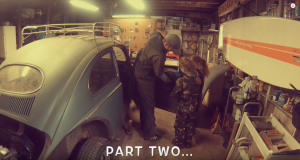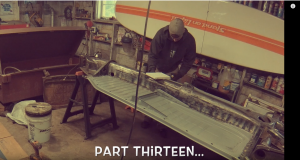Tools Needed:
If you’re doing the body work yourself, there are some tools that you won’t be able to go without. During the restoration of my ’67 bug, I acquired tools along the way – learning which tools I liked better than others, and which ones I could live without and which ones I couldn’t. In this step, you’ll need the following:
- Filler spreaders – filler spreaders are usually pretty cheap, but the important thing is having an assortment of different sizes and hardness for the panels you’re working on. I have a few soft/flexible spreaders varying in sizes from about 3″ to 6″, and a few stiffer ones the same sizes.
- Sanding blocks – the sanding blocks seem a little spendy for what they are, but they’re worth investing in. I built up a small arsenal of sanding blocks while working on my ’67 and they are worth every penny spent. Without sanding blocks, you risk creating grooves in the body work that will definitely be noticeable when it comes time to paint. Get a few different sizes and hardnesses of these too – ask you local auto paint supply shop what they recommend. I mainly use the 6″ softer block for small areas and sharply curved areas (under fenders, etc) and a 16″ hard block for broad work
- Sand paper – along with the blocks, of course you’ll need the sand paper. I buy rolls of paper at the local auto paint supply shop – the rolls have an adhesive side that sticks to the blocks, and makes switching paper really fast and easy. I buy a roll of 80 grit, 180 grit, and 220 grit for the beginning body work – when it comes time for the final prep before paint, I’ll share the grits used then.
- Filler – don’t skimp on the filler you choose. Some are better than others – but some also cost more than others. Get advice from your local auto paint shop – don’t just pick something off the shelf at a parts store. Even if it looks good before paint, some will rear their ugly heads later and ruin your paint job. I’m using Evercoat 156 and a glaze putty for a final semi-smooth surface. Later I’ll be using a filler primer to smooth out any imperfections and sand that down before sealing and painting. That will come later.
- Guide coat – guide coat is a paint that dries quickly and is easily sand-able. It will allow you to easily see high/low spots when working with the body filler.
Blocking in the rough stuff:
While the weather was still decent before winter hits, I decided to roughly block in some of the fenders and fill any of the larger dents before storing them away for winter. In the spring I’ll be doing the majority of the body work down to paint – but I wanted to get a jump start on it.
Since these fenders were previously primed with epoxy primer, I sanded the spots that I wanted to fill with 80 grit sandpaper to roughen up the surface and give the filler something to grab. After sanding, I wiped them clean with wax and grease remover and started mixing some filler. Depending what filler you’re using, and the climate you’re working in, the mixing process may be a little different. In general, you scoop a good amount of body filler onto your mixing palette with a paint stick or similar, then squeeze a line of hardener about the length of the filler and mix it.
There’s a trick to mixing it to prevent bubbles – this video from Eastwood explains how it’s done a little better than I can.
Once mixed, I applied the filler to the areas I had sanded – these spots had some pretty noticeable dents from where I had previously hammer/dollied them so I wanted to start getting them semi-smooth. When applying the filler, I try to lay it on as smoothly as possible. If it doesn’t go on smooth, it’s not the end of the world, but it will cause extra work when sanding. Letting the filler set up for about 15 minutes, I then hit it with the large sanding block with 80 grit paper.
The filler doesn’t need to be completely cured when you start to sand. If it’s still a little pliable, it makes it easier to knock the big stuff down and save some elbow work.
Keeping the sanding block flat along the panel, and sanding in opposite directions, I worked down the filler to be fairly flat to the fender. There were high spots from the previous hammer/dolly work which I used the ball peen hammer to knock back down so the filler can lay flat on the next batch. After the fender was semi-dent free, I used guide coat black to really see the high and low spots that I’ll need to take care of later. By sanding the guide coat, I could clearly see what needed to be done. The area I had filled earlier looked pretty good and what was left could be taken care of with glaze putty. The glaze putty is a filler that goes on smoother than regular filler, and is easier to sand to an almost-paint-ready finish.
My camera battery died before sanding the glaze putty, but I’ll get to more body work information later on in the spring. This was just a quick roughing in of the initial body work to be done while the weather was cooperating. Lots more body work later on…



